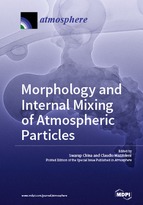Morphology and Internal Mixing of Atmospheric Particles
A special issue of Atmosphere (ISSN 2073-4433). This special issue belongs to the section "Aerosols".
Deadline for manuscript submissions: closed (15 November 2017) | Viewed by 70204
Special Issue Editors
Interests: aerosol health effects; atmospheric aerosol; climate change; multi-phase atmospheric chemistry
Special Issue Information
Dear Colleagues,
The lack of mechanistic knowledge on several aerosol properties and their complex interactions with clouds and radiation hinders the advance in predictive understanding of climatic and environmental impacts of atmospheric aerosol. Single particle morphology and internal mixing states are among those aerosol aspects that are the least known and characterized, due to their complexity and inherent measurement challenges. However, these single-particle aspects influence the aerosol optical properties, as well as various microphysical processes like hygroscopicity and heterogeneous ice nucleation. During the aerosol life cycle, particles experience several atmospheric aging processes, such as restructuring, coagulation and condensation with organic and inorganic materials, and heterogeneous chemical reactions. These processes result in changes in morphology and internal mixing state of individual particles. The significance of these effects and, hence, the impact on atmospheric radiation budget, is largely unconstrained and not well understood.
New experimental, as well as modeling, efforts are needed to better understand the role of aerosol morphology and internal mixing at the single-particle level. This Special Issue focuses on this timely topic, and we welcome both laboratory and field measurements, as well as modeling efforts that investigate the morphology and internal mixing of atmospheric particle, their chemical and physical interactions with the environment and their effects, for example, on optical properties and microphysical processes.
Dr. Swarup China
Dr. Claudio Mazzoleni
Guest Editors
Manuscript Submission Information
Manuscripts should be submitted online at www.mdpi.com by registering and logging in to this website. Once you are registered, click here to go to the submission form. Manuscripts can be submitted until the deadline. All submissions that pass pre-check are peer-reviewed. Accepted papers will be published continuously in the journal (as soon as accepted) and will be listed together on the special issue website. Research articles, review articles as well as short communications are invited. For planned papers, a title and short abstract (about 100 words) can be sent to the Editorial Office for announcement on this website.
Submitted manuscripts should not have been published previously, nor be under consideration for publication elsewhere (except conference proceedings papers). All manuscripts are thoroughly refereed through a single-blind peer-review process. A guide for authors and other relevant information for submission of manuscripts is available on the Instructions for Authors page. Atmosphere is an international peer-reviewed open access monthly journal published by MDPI.
Please visit the Instructions for Authors page before submitting a manuscript. The Article Processing Charge (APC) for publication in this open access journal is 2400 CHF (Swiss Francs). Submitted papers should be well formatted and use good English. Authors may use MDPI's English editing service prior to publication or during author revisions.
Keywords
atmospheric particles
morphology
internal mixing
single particle analysis and modeling
aerosol optical properties
radiative forcing
aerosol-cloud interactions
heterogeneous aerosol chemistry
aerosol imaging
microscopy







